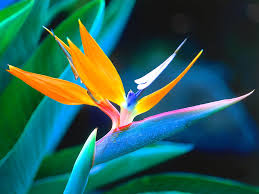Bird of Paradise

Jungle-Type Bird of Paradise Flowers
If you know bird of paradise mainly as a florist's flower, then most likely the type of bird of paradise with which you are familiar is Strelitzia reginae (see picture). A tropical plant indigenous to South Africa, Strelitzia reginae grows in warm, humid climates. Bird of paradise flowers can be grown as perennials in zones 9-11. This bird of paradise plant has long (ca. 18 inches by 6 inches wide), leathery leaves reminiscent of those on the banana tree (to which it is related). Bird of paradise "flower" rests atop a rigid stalk and is composed of orange sepals and blue petals. The plants grow in clumps and can reach 5 feet in height -- certainly large and showy enough to serve as focal points. Divide the clumps in late spring to early summer for propagation. Grow Strelitzia bird of paradise in full sun to partial shade and in a well-drained, acidic soil enriched by humus. Care for bird of paradise consists largely in removing dead plant material promptly (as a precaution against fungal attacks), along with proper watering and fertilizing: Keep the soil moist during the growing season, but water only when the soil is dry during the plant's period of dormancy. Likewise, keep fertilizing to a minimum while bird of paradise plants are dormant, but fertilize copiously with organic fertilizer (e.g., aged cow manure) during the growing season. If you use a synthetic fertilizer, look for something high in nitrogen (as indicated by the NPK number) and follow label instructions. One of the other Strelitzia bird of paradise flowers is Strelitzia nicolai, the white bird of paradise.
 Desert-Type Bird of Paradise Plants
Desert-Type Bird of Paradise Plants
Unrelated to the jungle-type bird of paradise are the following shrubs or small trees, native to tropical and sub-tropical regions of the Western Hemisphere, in the Caesalpinia genus and belonging to the legume family (the latter fact being easily surmised from a glance at their leaves):
- Red Bird of Paradise (Caesalpinia pulcherrima)
- Mexican Bird of Paradise (Caesalpinia mexicana)
- Yellow Bird of Paradise (Caesalpinia gilliesii)

 Desert-Type Bird of Paradise Plants
Desert-Type Bird of Paradise Plants
Unrelated to the jungle-type bird of paradise are the following shrubs or small trees, native to tropical and sub-tropical regions of the Western Hemisphere, in the Caesalpinia genus and belonging to the legume family (the latter fact being easily surmised from a glance at their leaves):
- Red Bird of Paradise (Caesalpinia pulcherrima)
- Mexican Bird of Paradise (Caesalpinia mexicana)
- Yellow Bird of Paradise (Caesalpinia gilliesii)
